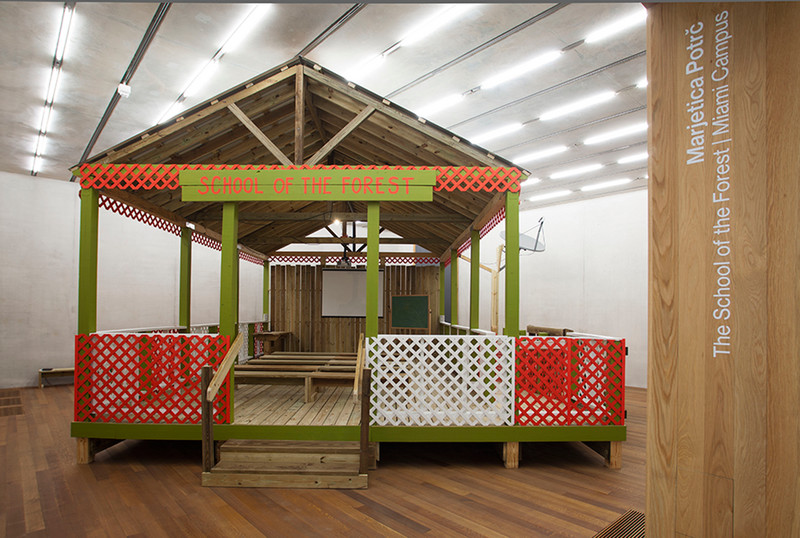Marjetica Potrč
11 Jun - 18 Oct 2015

Marjetica Potrč: The School of the Forest | Miami Campus
Installation view Pérez Art Museum Miami.
Photo: Oriol Tarridas.
Installation view Pérez Art Museum Miami.
Photo: Oriol Tarridas.
MARJETICA POTRČ
The School of the Forest | Miami Campus
11 June – 18 October 2015
The interdisciplinary work of Marjetica Potrč (b. 1953, Ljubljana, Slovenia; lives in Berlin and Ljubljana) encompasses community-based, participatory projects, as well as gallery installations referencing architectural conditions that she has observed around the world—from informal settlements in Caracas to experimental housing units in Jerusalem. These installations, which Potrč refers to as “case studies,” represent local organic responses to universal material and social needs, including shelter, energy, water, and communication.
Commissioned by Pérez Art Museum Miami, The School of the Forest | Miami Campus is a multipart endeavor that centers on the kind of elevated, open-air structures commonly used as communal gathering spaces among Amazonian forest communities, which the artist encountered while carrying out an extended research residency in the Brazilian state of Acre. Over the course of the exhibition period, a series of lectures, seminars, and workshops will be presented inside a structure inspired by this building type constructed in the gallery. The concept is based on the Universidade da Floresta (School of the Forest), an initiative launched in 2005 in rural Brazil to bring together the ideas of the region's local populations with those of Western theorists and scientists, treating both systems of thought on equal terms. Drawing on esteemed experts from around the world, the curriculum of the “Miami Campus” creates parallels between dynamics specific to the Amazon territories (such as water shortages, deforestation, and tribal rights issues) and various socioeconomic and ecological concerns relevant to South Florida. The broader goal is to construct the imaginary of a sustainable human relationship with nature in the Anthropocene age (a term that denotes the present geological era, in which human activity constitutes the dominant source of impact on the Earth’s climate, ecosystems, and topography). When the exhibition closes, the structure will be disassembled and its components distributed to various local urban farms, where they will be used to support the farms’ everyday activities.
The School of the Forest | Miami Campus
11 June – 18 October 2015
The interdisciplinary work of Marjetica Potrč (b. 1953, Ljubljana, Slovenia; lives in Berlin and Ljubljana) encompasses community-based, participatory projects, as well as gallery installations referencing architectural conditions that she has observed around the world—from informal settlements in Caracas to experimental housing units in Jerusalem. These installations, which Potrč refers to as “case studies,” represent local organic responses to universal material and social needs, including shelter, energy, water, and communication.
Commissioned by Pérez Art Museum Miami, The School of the Forest | Miami Campus is a multipart endeavor that centers on the kind of elevated, open-air structures commonly used as communal gathering spaces among Amazonian forest communities, which the artist encountered while carrying out an extended research residency in the Brazilian state of Acre. Over the course of the exhibition period, a series of lectures, seminars, and workshops will be presented inside a structure inspired by this building type constructed in the gallery. The concept is based on the Universidade da Floresta (School of the Forest), an initiative launched in 2005 in rural Brazil to bring together the ideas of the region's local populations with those of Western theorists and scientists, treating both systems of thought on equal terms. Drawing on esteemed experts from around the world, the curriculum of the “Miami Campus” creates parallels between dynamics specific to the Amazon territories (such as water shortages, deforestation, and tribal rights issues) and various socioeconomic and ecological concerns relevant to South Florida. The broader goal is to construct the imaginary of a sustainable human relationship with nature in the Anthropocene age (a term that denotes the present geological era, in which human activity constitutes the dominant source of impact on the Earth’s climate, ecosystems, and topography). When the exhibition closes, the structure will be disassembled and its components distributed to various local urban farms, where they will be used to support the farms’ everyday activities.
